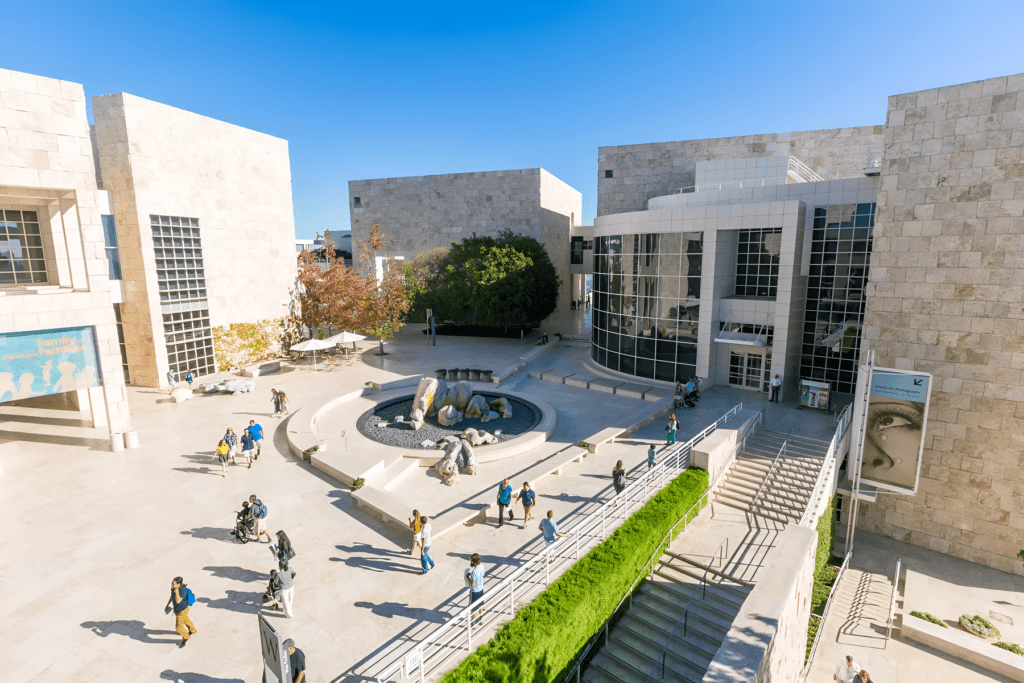The Getty, formally referred to as the J. Paul Getty Museum, is an ancient Art museum in Los Angeles, California. It houses an extensive collection of artworks and is renowned for its stunning architecture and gardens. In addition, the article also provides a general overview of the museum’s history, structure, and collections, as well as on information for visitors and materials about recent events.
History in the University area
The Getty Museum was founded by oil tycoon J. Paul Getty in 1953. Founded in a tiny Malibu cottage, it soon outgrew the facility. Getty built the antiquities museum in 1974, called The Getty Villa in Pacific Palisades, to exhibit its collection of Greek, Roman, and Etruscan art. By 1997, the museum had relocated to the Getty Center, where it exists today. The new building, designed by architect Richard Meier, massively increased the size of the museum’s collection and exhibit space.
Structure and Architecture
Artistic eye: Visitors to the Getty Center might mistakenly think they are coming simply for an exhibition space when they first see the complex, which seemingly hangs off the side of a hilltop in the Santa Monica Mountains. The campus spans more than 110 acres and is made up of many buildings that are connected by paths. It is built from white travertine stone, large glass windows, and an open floor plan. It offers unrestricted panoramic vistas of Los Angeles and its surroundings. Guests can wander through exquisitely landscaped gardens, including the Central Garden by artist Robert Irwin.
Museum Collection
The Getty has a much more comprehensive range of works—European paintings, sculptures, and decorative arts. Among them are pieces from artists such as Vincent van Gogh, Rembrandt, and Claude Monet. The museum also boasts of archive of photographs, manuscripts, and antiques. Highlights include Van Gogh’s “Irises” and Rembrandt’s “Portrait of a Young Woman.”
Getty Villa: This museum specializes in ancient art and houses an assortment of 44,000 objects, including sculptures, pottery, and coins. It provides some insight into the treatment of the dead in ancient Greece and Rome, as well as in Etruria. Temporary exhibitions on a particular theme or artist are used to encourage visitors to look at the collections in new ways.
Gardens and Scenic Views
Here at the Getty Center, you have to experience both art and nature. Central Garden – designed by artist Robert Irwin, the garden is an ever-changing work of art that includes a unique mix of plants and trees, a water feature, and walkways through the azalea maze. Guests will then enjoy panoramic views of the Los Angeles skyline and Pacific Ocean from up above. At the Getty Villa, visitors escape to a Roman oasis with meandering paths that border reflecting pools and fountains surrounded by Mediterranean fauna.
Practice and Accessibility Educational Programs
The more than 100 programs at the Getty Museum are organized by staff who have both curatorial and educational titles to encourage lifelong learning in accessible ways, including art-making workshops, lectures for all-ages audiences (again not just served as a family offering), docent-guided tours researched through their partnership with International scholarly colleagues. Its place will be free to admission, providing wide accessibility to the resources it holds within the building. Moreover, the museum has its tram connecting a lower hill with the Getty Center GUI–advantageous for ensuring access rights and making this digital product suitable for diverse age groups.
Preservation and Conservation
The J. Paul Getty Trust and the world’s most prosperous art institution are providing resources for research on conservation efforts by covering all areas of this controversial field from many different angles. One of the ways in which we work on this goal is through collaboration with museums around the world, helping them protect and conserve their artworks: it means that Getty owns art for all people everywhere. Coupled with acquisitions and research, these conservation initiatives help to uphold the museum’s world-class collection.
Time to Visit
The Getty Museum is open 365 days a year, but hours vary by season. Weekdays, early morning, or late afternoon are the best times to visit. By opening in the summer, smaller numbers, of course, visitors mean that they can avoid doing what is lovely to document elsewhere — crowding around the smallest shards and standing cheek-to-jowl with like-minded stampeding hordes — quite yet. Flowers are blooming, and the weather is nice in Spring and Fall, which makes it a perfect time to head out and see more gardens.
The museum is entrance-free. However, parking would cost you around $20. Over weekends or holiday periods, booking parking in advance is recommended to make sure you get all the benefits.
Visitor Details
The expansive amenities at The Getty Center A variety of dining options are available at the property, including a restaurant and cafe. The gift-centered store has otherwise art books and unconventional souvenirs. We have our ever-popular wheelchair rentals, which have been a favorite for visitors with disabilities by marking each year’s maps.
Led tours are also available for folks who want to learn more about the art and architecture. Audio guides also improve the visitor experience by offering thoughtful interpretations of the collections.
Latest News
This summer the Getty Museum revealed it will be extending its educational programs. The initiatives are designed to connect with the community through workshops, lectures, and interactive exhibits. The museum is also working to boost its digital footprint, making virtual tours and online exhibits available to people around the world. Finally, the Getty has also launched a new series of rotating exhibitions that focus on contemporary artists and examine issues about modernity.
Meanwhile, the Getty Foundation is pursuing conservation efforts to keep its records intact. These works include the restoration and preservation of artwork as well as enhancements to the museum.

